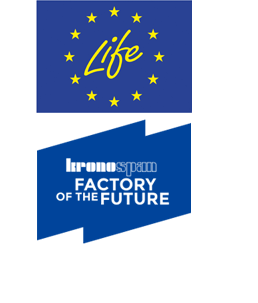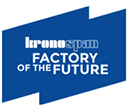Town water. At the end of the project Kronospan reduced its consumption per cubic metre of product by 37% of 2010, instead of foreseen 70-75%. With CHP operational, the low energy heat recovered from the electricity production will allow a saving in consumption of vapours produced by the main boiler for the “pre-cooking” of the wood chips. This saving is estimated to go up to 22% of consumption of 2010 consumption. After the full installation and optimisation of the CHP, the water consumption per cubic metre of product is expected to approach 40% of the reference year 2010.
Natural gas and fossil CO2 equivalent emissions. By replacing natural gas with wood, the consumption and the CO2 equivalent emissions per cubic meter of generic product have been reduced at the end of the project by 59%, respectively 58%, compared to 2010. The objective of reducing the natural gas by 90% of 2010, could not be assured at a yearly scale due to the unreliability of the multi-fuel burners when running at low natural gas ratio (5%). Same is true for the 80% annual reduction of CO2 equivalent emissions. The objectives of natural gas and fossil CO2 eq. reduction can be achieved in a stable manner only after the implementation and full optimisation of the wood-energy CHP, of which “green” heat replaces at least 90% of the heat obtained in 2010 from natural gas burning.
Water and carbon footprint evolution
Tap water consumption
Tap water consumption per cubic metre of output was reduced by 37% in 2016 compared with 2010, and by 41% compared with 2009. Part of these savings were made from the elimination of water losses detected during the control phase. The most were due to the use of recycled water (rainwater and condensate) in the parts of the production line not requiring high standard water quality (washing wood chips for MDF, scrubbing exhaust gases).
Natural gas consumption
Due to the increase in wood-energy, the natural gas consumption per cubic metre of output fell by 59% in 2016 compared with 2010, and by 69% compared with 2009.
Following the natural gas trend, the CO2 equivalent emissions from fossil fuels (per cubic metre of output) fell in 2016 by 58% compared with 2010, and by 69% compared with 2009.
Wood-energy consumption
The wood-energy ratio per cubic metre of output grew by 38% in 2016 compared to 2010, and by 77% compared to 2009.
Environmental impact evaluation from cradle to gate
The use of Life Cycle Assessment (LCA) as environmental evaluation method was instrumental to identify if we were moving pollution from one category of impact to another as well as to monitor and prove the progress in reducing the environmental footprint, year after year. LCA also allowed the downscaling of the environmental improvements reached at the site level using a cradle-to gate perspective, also allowing the breakdown on types of products.
The CFA of the production site is made in complement to the existent CFA of products, allowing comparability and consolidation of results.
Life Cycle Assessment (LCA) of Kronsopan’s products
The Life Cycle Impact Assessment (LCIA) methodology employed was IMPACT 2002+ which proposes a combined damage-oriented approach. The environmental performance is expressed as single score.
The single score environmental impact, cradle-to-gate, of a generic cubic meter of OSB product is reduced in 2016 by more than 11% compared to the reference year of the project, 2010.
For a generic cubic meter of MDF the reduction cradle-to-gate in 2016 is more than 7%.
For both categories of products the reduction is mainly due to the reduction of natural gas use which led to significantly less impact on “Climate change” and “Resources”.
For OSB, Human health and Ecosystem quality remain relatively constant since 2009.
For a generic m3 of Kronospan MDF we can observe that using more wood increases marginally the Human Health (+1%) and the “Ecosystems quality” impact (+2% of total damage in 2010), mainly due to the raise in terrestrial ecotoxicity and land occupation.
The transfer of damage from one category of impact to another theoretically exists, but only for MDFs (from Climate Change and Resources to Human health and Ecosystem quality), however it is very small and not considered statistically significant.
Carbon Footprint Analysis (CFA) of Kronospan’ production site
The complementary CFA of the production site shows that the daily commuting of employees have by far the most important contribution to the site’s carbon footprint, i.e. more than two thirds of the total greenhouse gas emissions. This is explainable by the remoteness of the transport networks: over 1.5 to the nearest bus station, and over 3 kilometres to the nearest railway station.
The second contribution to the site’s carbon footprint (one quarter of total) belongs to the heating of the spaces not related to production.

